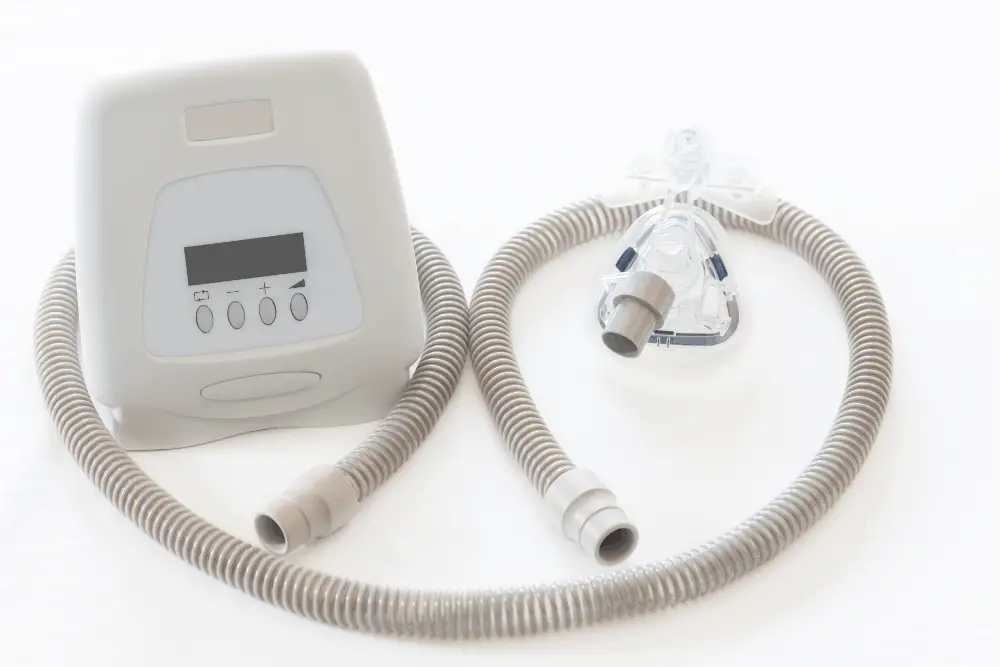No, CPAP machines do not consider oxygen as they use a continuous stream of air that contains the normal elements we breathe in regularly like oxygen, nitrogen, and carbon dioxide, it works this way to keep your airways open and not to directly deliver oxygen to the body.
The CPAP mask works by delivering air to your airways to prevent the soft tissue in the back of the throat from collapsing. This presentation will help the person to continue breathing regularly during their sleep.
The oxygen concentration in CPAP machines is only around 21% whereas the oxygen concentration from oxygen therapy or an oxygen concentrator machine is above 85%. Oxygen therapy is the process of delivering oxygen to the body and is mainly given to people who struggle with heart or breathing problems who need oxygen-rich air to function properly.
If you are someone who has other medical conditions then your doctor may consider giving you added oxygen with your CPAP machine.
Can I use oxygen instead of CPAP?
No, oxygen should not be used on its own to replace CPAP. The delivery of oxygen on its own is not enough to keep the airway at the back of the throat open therefore will not be efficient in preventing sleep apnea.
Even though oxygen will be flowing through the mask, there will still be breathing interruptions as the throat will not be able to stay open and the oxygen will not be inhaled at all.
It may be beneficial to give some patients oxygen with CPAP but other patients will not need the additional oxygen given to them. CPAP is used for sleep apnea because it uses a more forceful stream of air to keep the back of the throat open and to let air flow through so the person can breathe properly whilst they sleep.
Does CPAP raise oxygen levels?
Yes, CPAP does raise oxygen levels because it opens up the back of the throat and allows for airflow to get to the lungs so then more oxygen can be absorbed by the blood.
However, CPAP alone will not be used to primarily raise oxygen levels in the blood as it only uses regular airflow that we normally breathe to help soften the tissue at the back of the throat.
If someone who struggles with sleep apnea needs to raise their oxygen levels then they’ll need to add oxygen into their CPAP as the CPAP only uses regular airflow from what we normally breathe.
How do you hook up oxygen to a CPAP machine?
If you’re someone who does struggle with respiratory problems, has trouble with maintaining good oxygen levels in their blood as well as having sleep apnea then you may want to use oxygen with your CPAP machine.
You will add an oxygen concentrator to your CPAP machine which can be connected in two locations - via an oxygen port on the CPAP mask or between the CPAP machine and the tubing of the CPAP.
Follow these steps to securely hook up your oxygen to your CPAP machine:
- If your mask doesn’t feature an oxygen port then you’ll need to use an oxygen bleed-adapter. However, some masks that do have oxygen ports may be covered by a cap that needs removing
- Connect your CPAP tubing with the tubing of your CPAP mask
- Get your bleed-in-adapter and secure it to the opposite end of your CPAP tubing by pushing it as far forward as possible
- Once your tubing, mask, and adapter together you’ll need to connect your cannula to the oxygen concentrator to the small end of the bleed-in-adapter by pushing it over the nob until it is secure
- Your final step is to connect everything to your CPAP machine and then you’re ready to turn everything on to use
You should always have your CPAP machine on before you turn the oxygen machine on and then you should always turn the oxygen off before you turn the CPAP machine off.
Your doctor should show you the way that you should connect your CPAP machine to an oxygen concentrator so you can do it yourself at home. Some CPAP machines and oxygen concentrators will differ so you’ll need to read the user manual to find out how to effectively put everything together.
If you are using an oxygen concentrator with a CPAP machine then you may experience some nasal dryness or a dry throat, so you could use a heated humidifier to moisten the air so you feel more comfortable.

How many liters per minute does CPAP use?
CPAP machines will offer different amounts of pressure between brands and the amount of pressure given to a patient will depend on their sleep apnea and how severe it is.
Those who struggle with sleep apnea normally require a CPAP pressure of around 6-14cm H2O, however, the average CPAP pressure is around 10cm H2O.
The Boussignac and Flow-Safe CPAP machines have starting oxygen flow of 15 liters per minute and can be adjusted up to an oxygen flow of 25 liters per minute. The Emergent Port O2 CPAP machine has a H2O level of 0-2cm and goes up to a maximum pressure of 10cm H2O.
How does CPAP improve oxygenation?
A CPAP machine works by delivering positive end-expiratory pressure to help maintain the set pressure throughout the respiratory cycle.
As this positive end-expiratory pressure is maintained it increases the surface area of the alveolus and improves oxygenation.
Can CPAP damage your lungs?
If you don't clean your CPAP regularly then you could be causing damage to your lungs and even develop respiratory problems. CPAP machines can blow bacteria and viruses into your lungs and increase the risk of respiratory infections like pneumonia.
Enhanced cleaning of the tubing and the mask should be performed to reduce the risk of any infections.
How to clean your CPAP?
Not regularly cleaning your CPAP tubing can lead to you being exposed to mold and bacteria which can lead to infections. This can also lead to allergies and even cause you to break down early, this may void your warranty so you’ll lose out on money.
You should aim to clean your equipment on a weekly basis at least, if you struggle with allergies or have regular respiratory infections then you may want to clean your equipment on a daily basis.
You should use mild dish soap, a soft cloth, and warm water to help clean your equipment. Make sure your equipment is turned off and unplugged before cleaning it and leave everything to dry thoroughly before using it again.

Damon Wiseley is a Registered Respiratory Therapist and Certified Pulmonary Function Technologist.
